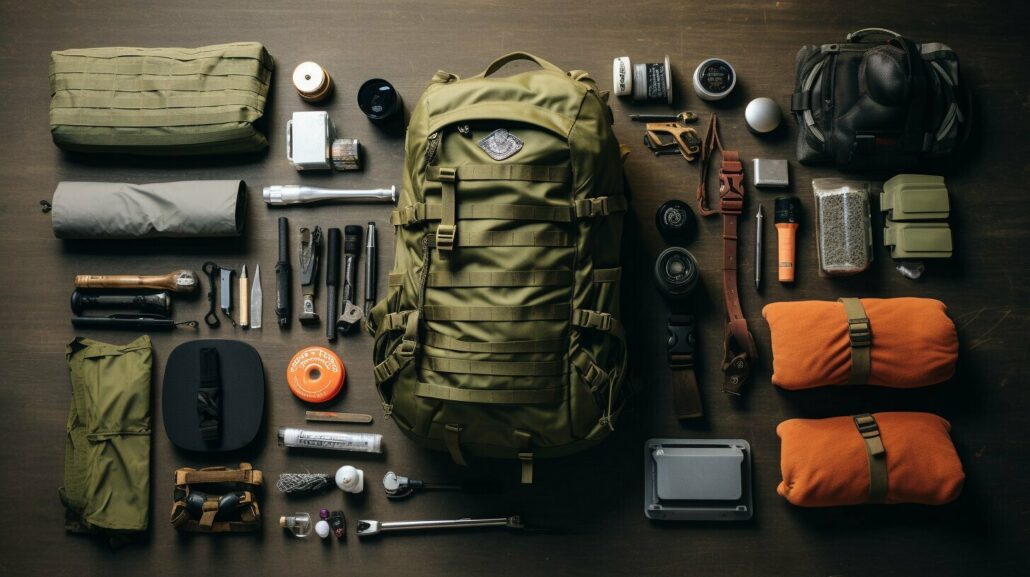In this easy guide, I will show you how to create a simple bug out bag using essential items that you can gather right away.
Key Takeaways:
- A bug out bag is a portable emergency disaster survival kit that includes essential items for short-term survival.
- The bag should address the most likely disruptive events in your area and be road-worthy.
- Keep your bug out bag lightweight, under 20 pounds, to ensure easy mobility.
- Include items such as water filters, flashlights, knives, first aid kits, and food supplies.
- Remember to have a separate first aid kit and a WUSH Bag next to your bed for immediate access.
Understanding Bug Out Bags and Emergency Preparedness
Before we dive into assembling a bug out bag, let’s first understand what it is and why it’s crucial for emergency preparedness. A bug out bag is a portable emergency disaster survival kit that contains essential items to sustain you in case of a short-term crisis or evacuation. Think of it as your go-to solution when you need to quickly grab everything you need to survive and thrive in unexpected situations.
A well-prepared bug out bag should be carefully thought out and tailored to address the most likely disruptive events in your area. It should be road-worthy, easily accessible, and lightweight, weighing no more than 20 pounds. The key is to strike the perfect balance between having all the necessary supplies and keeping the bag manageable and easy to carry.
When assembling your bug out bag, consider including essential items such as water filters or water purification tablets to ensure you have access to clean drinking water. Flashlights, knives, and first aid kits are also crucial for navigating through challenging situations. Additionally, consider packing fire-making supplies, food and cooking utensils, communication devices, hygiene and medication supplies, power sources, and important documents.
| Key Components of a Bug Out Bag | Additional Considerations |
|---|---|
|
|
In addition to the main bug out bag, it is also recommended to have a separate first aid kit for quick access to medical supplies. This ensures that you’re prepared to deal with any injuries or illnesses that may occur during an emergency situation.
Lastly, consider creating a WUSH (Wake Up, Stuffs Happening) Bag, an ultra-portable emergency kit that sits next to your bed. This bag should contain essentials like cash, identification documents, prescriptions, backup USB drives, and other items you might need in case you have to evacuate in the middle of the night.
Conclusion
Now that we understand what a bug out bag is and its significance for emergency preparedness, we can move on to the next section, where we’ll explore the essential items you need to include in your bug out bag. Remember, being prepared is the key to effectively facing unexpected challenges, and having a well-equipped bug out bag is a crucial step in that direction.
Bug Out Bag Essentials: What You Need to Know
Let’s take a closer look at the essential items that should be on your bug out bag checklist to ensure you have everything you need for short-term survival. A bug out bag is a portable emergency disaster survival kit that includes essential items to help you navigate unexpected challenges. It’s crucial to be prepared for disruptive events by having a well-equipped bag that addresses the most likely scenarios in your area.
Essential Items for Your Bug Out Bag
When assembling your bug out bag, it’s important to prioritize items that will help you survive in various situations. Here’s a checklist of bug out bag contents that you should consider:
- Water filters or purification tabs: Ensure you have access to clean drinking water.
- Flashlights and extra batteries: Provide illumination when there is a power outage.
- Knives or multi-tools: Useful for various tasks and emergencies.
- First aid kits: Include basic medical supplies and medication.
- Fire-making supplies: Lighters, waterproof matches, or fire starters for warmth and cooking.
- Food and cooking supplies: Pack non-perishable food items and cooking utensils.
- Communication devices: Keep a charged cellphone or a two-way radio for communication.
- Hygiene and medication supplies: Include toiletries, personal hygiene products, and any necessary prescription medications.
- Power sources: Portable chargers or solar panels for recharging electronic devices.
- Important documents: Photocopies of identification documents, insurance policies, and contact information.
Remember, this is not an exhaustive list, but it covers the bug out bag supplies that should be prioritized. It’s crucial to customize your bag based on your specific needs and the potential disruptive events in your area. Researching and understanding the likely scenarios will help you choose the most essential items.
| Item | Importance |
|---|---|
| Water filters or purification tabs | High |
| Flashlights and extra batteries | High |
| Knives or multi-tools | High |
| First aid kits | High |
| Fire-making supplies | Medium |
| Food and cooking supplies | Medium |
| Communication devices | Medium |
| Hygiene and medication supplies | Medium |
| Power sources | Medium |
| Important documents | Low |
Being prepared with a well-stocked bug out bag can make a significant difference in your ability to survive and navigate through challenging situations. Remember to periodically check and update your bag, ensuring that all the items are in good condition and not expired. Stay vigilant, and may your bug out bag be ready to help you face any unexpected events.
Building Your Bug Out Bag: Step-by-Step Guide
Now that you know what to include in your bug out bag, let’s go through the step-by-step process of assembling it. Remember, the goal is to have a lightweight and road-worthy bag that contains all the necessary supplies for short-term survival.
Step 1: Choose the Right Bag
Start by selecting a bag that is durable, comfortable, and spacious enough to hold all your essentials. Look for a backpack with multiple compartments and sturdy straps for easy carrying. Consider a water-resistant bag to protect your items from the elements.
Step 2: Organize Your Supplies
Create a checklist of the essential items you need to include in your bug out bag. Categorize them into groups like shelter, food and water, first aid, tools, and communication. This will help you organize your supplies and ensure nothing is forgotten.
| Category | Items |
|---|---|
| Shelter | Tent, sleeping bag, emergency blanket |
| Food and Water | Water filters, water purification tabs, non-perishable food |
| First Aid | First aid kit, medications, bandages |
| Tools | Knife, multi-tool, fire starter |
| Communication | Portable radio, whistle, cell phone with spare battery |
Step 3: Pack Strategically
When packing your bug out bag, prioritize the items that you may need to access quickly in an emergency. Keep heavier items closer to your back for better weight distribution. Use smaller compartments for organizing smaller items and keep frequently used items easily accessible.
Step 4: Test and Adjust
Once you have assembled your bug out bag, take it for a test run. Walk around with it for a while to see if the weight is manageable and the straps are comfortable. Make any necessary adjustments to ensure your bag fits perfectly and doesn’t strain your body during prolonged use.
By following this step-by-step guide, you can create a bug out bag that meets your specific needs and ensures you are prepared for unexpected challenges. Remember to regularly review and update your bag’s contents as needed to keep it up to date and ready for any situation that may arise.
Please also check out my Ultimate Bug Out Bag here.
Additional Considerations for Bug Out Bags
Apart from the essentials, there are some additional considerations to make your bug out bag even more effective in emergency situations. These additional items and upgrades can enhance your preparedness and ensure you have the tools and resources needed to navigate challenging circumstances.
Survival Tools
Incorporating a variety of survival tools in your bug out bag can significantly improve your ability to handle different situations. Consider including items such as a multi-tool, paracord, duct tape, a compass, a signaling mirror, and a hand-crank radio. These tools can assist with navigation, shelter building, communication, and basic repairs, making them invaluable in survival scenarios.
Upgrades and Additions
Enhancing your bug out bag with upgrades and additions can further optimize its effectiveness. For example, you may want to invest in a high-quality backpack with padded straps and extra compartments for better organization. Adding waterproof storage bags or containers can protect your gear from moisture and ensure it remains in good condition. Additionally, consider including extra batteries, spare parts, and additional food and water supplies to extend the duration of your survival kit.
Communication Devices
In times of crisis, staying connected with others and receiving vital information is crucial. Including communication devices in your bug out bag can help you achieve this. Consider adding a portable hand-crank or solar-powered radio to stay updated with emergency broadcasts. A fully charged cell phone with a portable charger can provide a lifeline to the outside world. Additionally, a whistle and a signal mirror can be used to attract attention and communicate over long distances.
| Survival Tools | Upgrades and Additions | Communication Devices |
|---|---|---|
| Multi-tool | High-quality backpack | Portable hand-crank radio |
| Paracord | Waterproof storage bags | Cell phone with portable charger |
| Duct tape | Extra batteries | Whistle |
| Compass | Spare parts | Signal mirror |
By considering these additional factors, you can create a bug out bag that is even more comprehensive and well-rounded. Remember to regularly review and update your kit to ensure it remains current and meets your specific needs. With the right tools and resources at hand, you can face emergency situations with confidence and greater peace of mind.
Environmental Protection: Clothing and Shelter
When it comes to bug out bags, ensuring environmental protection through proper clothing and shelter is vital for survival. In a crisis situation, having the right gear can make all the difference in staying safe and comfortable. Let’s take a closer look at the essentials for protecting yourself from the elements.
Appropriate Clothing
Having the right clothing can help you stay warm, dry, and protected from harsh environmental conditions. Consider packing lightweight, moisture-wicking layers that can be easily added or removed as needed. A well-equipped bug out bag should include:
- A durable and weather-resistant jacket or poncho
- Thermal base layers to retain body heat
- Sturdy pants and comfortable, moisture-wicking socks
- Sturdy, waterproof boots for walking over various terrains
- A wide-brimmed hat or cap to shield against sun exposure
Shelter-Building Techniques
In addition to proper clothing, knowing how to build shelters can provide essential protection and increase your chances of survival. Here are a few techniques to consider:
- Lean-to: Using a tarp or poncho, tie one end to a tree or secure it with stakes on the ground. Angle the tarp so that it provides a sloping roof to shield you from rain or snow.
- Debris Hut: Create a frame using sturdy branches and cover it with layers of leaves, moss, or other natural materials. This technique provides insulation and helps retain body heat.
- Tent: If you have space and weight permits, consider including a lightweight and compact tent in your bug out bag. This will offer a more comfortable and efficient shelter option.
Remember to practice these shelter-building techniques in advance to ensure familiarity and efficiency when the need arises. Additionally, having a small, portable shovel or multi-tool can greatly assist in constructing shelters.
| KEY TAKEAWAYS |
|---|
| Proper clothing is essential for environmental protection in bug out bags. Include weather-resistant jackets, thermal base layers, sturdy pants and boots, and hats to shield against sun exposure. |
| Shelter-building techniques are crucial for surviving in challenging environments. Lean-to, debris hut, and tents are effective options that provide protection and insulation. |
Water and Food: Prioritizing Basic Needs
In any emergency situation, water and food are essential for survival, making them a priority in your bug out bag. When preparing your bag, it’s crucial to anticipate the need for water purification and ensure an adequate supply of food. Staying hydrated is vital for maintaining physical and mental well-being, especially during high-stress situations.
One effective method of water purification is through the use of water filters or water purification tablets. These compact and lightweight tools can effectively remove contaminants and make water safe for consumption. Including these items in your bug out bag will allow you to source water from various locations such as rivers, streams, or even rainwater.
When it comes to food supplies, it’s advisable to pack non-perishable items that provide essential nutrients and require minimal preparation. This ensures that you have sustenance even when access to fresh food is limited. Examples of suitable food supplies for your bug out bag include energy bars, canned goods, dehydrated meals, and snacks with a long shelf life. Consider individual dietary needs and preferences when selecting food items. It’s also wise to periodically rotate these supplies to maintain freshness.
| Water and Food Essentials | Quantity |
|---|---|
| Water filters or purification tablets | 2-3 |
| Energy bars and snacks | 3-4 days’ worth |
| Canned goods | 5-7 cans |
| Dehydrated meals | 2-3 packets |
Remember to regularly check and replenish your water and food supplies to avoid expiration or spoilage. By prioritizing water purification and ample food provisions, you can better ensure your basic needs are met during an emergency situation.
Sleeping Gear: Resting for Optimal Performance
A good night’s sleep is crucial for maintaining physical and mental resilience in emergency situations, which makes having appropriate sleeping gear in your bug out bag essential. When faced with uncertain circumstances, having the ability to rest and recharge can significantly impact your ability to navigate challenges effectively. In this section, we will explore the key considerations for selecting sleeping gear that is lightweight, compact, and provides optimal comfort.
First and foremost, it is important to choose a sleeping bag that suits the environmental conditions you may encounter. Look for a bag that is rated for the lowest temperatures you are likely to experience. The insulation material, such as down or synthetic fibers, should be chosen based on your needs, taking into account factors like weight, compressibility, and moisture resistance.
In addition to a sleeping bag, a sleeping pad is another crucial component of your bug out bag. A quality sleeping pad provides insulation from the ground, enhances comfort, and improves overall insulation by minimizing heat loss through conduction. Look for a pad that offers a good balance between comfort and weight, while still providing sufficient insulation for the conditions you anticipate. Consider options like inflatable pads, self-inflating pads, or closed-cell foam pads depending on your needs and preferences.
To further enhance your sleeping comfort, consider including a compact and lightweight pillow in your bug out bag. While it may seem like a small luxury, having a comfortable pillow can greatly improve your quality of sleep and overall well-being during challenging times. Look for inflatable or compressible pillows that offer a good balance between portability and comfort.
| Sleeping Gear Checklist |
|---|
| Sleeping bag |
| Sleeping pad |
| Pillow |
Remember, the goal is to keep your bug out bag lightweight and portable, so choose sleeping gear that strikes a balance between functionality and weight. By prioritizing your sleeping needs and selecting appropriate gear, you can ensure that you are well-rested and ready to face whatever challenges may come your way in emergency situations.
First Aid: Treating Injuries and Illnesses
Having a well-stocked first aid kit is crucial to provide immediate medical care for injuries and illnesses that may occur during emergencies. In a bug out bag, it is essential to include a comprehensive first aid kit that covers a range of medical needs. Here are some key items to consider including:
- Bandages and gauze: These are essential for dressing wounds and preventing further damage.
- Antiseptic wipes and ointments: These help clean and disinfect wounds, reducing the risk of infection.
- Pain relievers: Include over-the-counter pain medications like acetaminophen or ibuprofen to alleviate pain and reduce inflammation.
- Tweezers and scissors: These tools are useful for removing splinters, cutting tape or dressings, and performing minor surgical procedures.
- Medical gloves: Gloves provide protection against infection and ensure sanitary conditions when treating injuries.
“Safety doesn’t happen by accident.”
It is important to familiarize yourself with the items in your first aid kit and know how to use them effectively. Consider including a first aid manual or basic medical guide to provide instructions in case of emergencies. Additionally, periodically check your first aid supplies and replace any expired medications or items that have been used.
| Item | Quantity |
|---|---|
| Bandages (assorted sizes) | 10 |
| Gauze pads | 10 |
| Antiseptic wipes | 20 |
| Antibiotic ointment | 1 tube |
| Pain relievers | 20 tablets |
| Tweezers | 1 pair |
| Scissors | 1 pair |
| Medical gloves | 5 pairs |
Remember, a bug out bag is meant to provide for your basic needs during emergencies, and having a well-equipped first aid kit is an essential component of that. By ensuring you have the necessary medical supplies and knowledge, you can be better prepared to handle injuries and illnesses and increase the chances of a successful survival outcome.
Power Sources and Communication: Staying Connected
In the modern age, having reliable power sources and communication devices in your bug out bag can make a significant difference during emergencies. When disaster strikes, the ability to stay connected with loved ones and receive vital information can be a lifeline.
Power Sources: One essential item to include in your bug out bag is a portable power source. These compact devices can keep your communication devices, such as cell phones and radios, charged when traditional power sources are unavailable. Look for power sources that have multiple USB ports and are compatible with a variety of devices. Consider solar-powered options, as they can be recharged using sunlight, making them a sustainable choice.
Communication Devices: Alongside a reliable power source, it’s crucial to have communication devices that can connect you with others during an emergency. A portable two-way radio can be invaluable for keeping in touch with your group or receiving updates from emergency services. Make sure to have spare batteries or a rechargeable power source for your communication devices to ensure they are always ready for use.
Backup Plan:
In addition to your bug out bag, it’s wise to have a backup communication plan. This could involve memorizing important phone numbers, creating a meeting point with your loved ones in case of separation, and having a designated contact person outside of your immediate area who can act as a hub for information. A backup plan ensures that even if your communication devices fail, you still have a way to connect with others.
| Power Sources | Communication Devices |
|---|---|
| – Portable power source | – Portable two-way radio |
| – USB ports for charging devices | – Spare batteries or rechargeable power source |
| – Solar-powered options |
Having reliable power sources and communication devices in your bug out bag is essential for staying connected and informed during emergencies. Alongside a portable power source, consider including a portable two-way radio and spare batteries. Remember to have a backup plan in case your communication devices fail. By prioritizing power sources and communication, you can enhance your preparedness and increase your chances of staying safe in unpredictable situations.
WUSH Bag: An Ultra-Portable Emergency Kit
In addition to your bug out bag, it’s recommended to have a WUSH Bag, an ultra-portable emergency kit that provides additional essentials within easy reach. The WUSH Bag is designed to be kept next to your bed, ensuring quick access to crucial items in case of an emergency.
The WUSH Bag should contain items that are essential for your immediate needs. These include cash, identification documents, prescription medications, and backup USB drives containing important files and documents. By having these essentials readily available, you can quickly grab your WUSH Bag and be prepared to face unexpected situations without wasting precious time searching for vital items.
It’s important to regularly check and update the contents of your WUSH Bag to ensure that everything is up to date and in working condition. Consider keeping a small flashlight, a whistle, and a spare set of house keys in your WUSH Bag as well. These additional items can provide extra security and peace of mind during emergencies.
| Items to Include in Your WUSH Bag: |
|---|
| Cash in small denominations |
| Identification documents (ID, passport, etc.) |
| Prescription medications |
| Backup USB drives with important files |
| Flashlight |
| Whistle |
| Spare house keys |
A well-prepared bug out bag is essential for your overall emergency preparedness. However, having a separate WUSH Bag adds an extra layer of convenience and readiness. By keeping your WUSH Bag close by, you can ensure that you’re prepared for unexpected events and can quickly access the essentials you need to navigate through challenging situations.
Make sure to also have a look at my Surival Bootcamp where I discuss this topic and much much more!
Conclusion
By following this easy guide and assembling a simple bug out bag, you can be better equipped to face unexpected challenges and ensure your survival during emergencies. A bug out bag is a portable emergency disaster survival kit that includes essential items for short-term survival. It should be prepared ahead of time and stored in an easily accessible location, addressing the most likely disruptive events in your area and being road-worthy.
When assembling your bug out bag, it is important to keep it lightweight, ensuring it does not exceed 20 pounds. Some essential items to include are water filters, water purification tabs, flashlights, knives, first aid kits, fire-making supplies, food and cooking supplies, communication devices, hygiene and medication supplies, power sources, and important documents.
In addition to the bug out bag, it is recommended to have a separate first aid kit and a WUSH (Wake Up, Stuffs Happening) Bag. The first aid kit should contain basic medical supplies for treating injuries and illnesses. The WUSH Bag is an ultra-portable emergency kit that sits next to your bed and contains essentials like cash, ID, prescriptions, and backup USB drives.
To ensure comprehensive preparedness, prioritize environmental protection by including appropriate clothing for different weather conditions and learning how to build shelters for protection. It is also crucial to prioritize water purification methods and select and store food for emergencies. Adequate sleeping gear is essential for restful sleep and optimal physical and mental performance.
By following these guidelines and considering additional factors like survival tools, upgrades and additions, and alternative sources of water and food, you can enhance your preparedness and be better prepared to face any unexpected challenges that may arise.
FAQ
Q: What is a bug out bag?
A bug out bag is a portable emergency disaster survival kit that contains essential items for short-term survival.
Q: Where should I store my bug out bag?
Your bug out bag should be prepared ahead of time and stored in an easily accessible location.
Q: What should I consider when preparing my bug out bag?
You should consider the most likely disruptive events in your area and ensure that your bag is road-worthy and lightweight, not exceeding 20 pounds.
Q: What are some essential items to include in a bug out bag?
Some essential items to include in a bug out bag are water filters, water purification tabs, flashlights, knives, first aid kits, fire-making supplies, food and cooking supplies, communication devices, hygiene and medication supplies, power sources, and important documents.
Q: Should I have a separate first aid kit?
Yes, it is recommended to have a separate first aid kit in addition to your bug out bag.
Q: What is a WUSH Bag?
A WUSH (Wake Up, Stuffs Happening) Bag is an ultra-portable emergency kit that sits next to your bed and contains essentials like cash, ID, prescriptions, and backup USB drives.
Q: What items should I prioritize in my bug out bag?
It is recommended to prioritize environmental protection (clothing), water purification, food supplies, sleeping gear, and first aid.
Q: Can I include survival tools and upgrades in my bug out bag?
Yes, it is suggested to include survival tools, upgrades, and additions like communication devices to enhance your preparedness.
Q: Should I learn how to build shelters and find alternative sources of water and food?
Yes, it is important to learn how to build shelters and find alternative sources of water and food in emergency situations.










